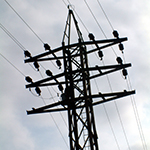
Principles of Sustainability
Chapter 6 - Energy Sustainability
Part 3 - Electricity: Transmission, Distribution and Economics

One of the key challenges to understanding energy sustainbility is the transmission, distribution and economics of electricity. Exploring this system of how we get electricity to the users – into our homes and businesses – once it is generated at the power station, is a critical point of study. This system is called the Grid. Electricity is generated at the power station/plant, is then sent through transmission lines to substations, from there to distribution lines which ultimately deliver electricity to homes and businesses.
Unfortunately, one of the current limitations of electricity is that it cannot be easily stored, unlike gas or oil, and thus must be generated and delivered at the precise moment when it is needed. To reach consumers, electricity travels at the speed of light from the power plant through miles of transmission and distribution lines until it reaches its destination. Electricity travels through the path of least resistance, often through a material such as metal, in a manner similar to the way water moves downstream. Utilities have interconnected their transmission lines into what is called a grid, so that they may buy, sell and transfer power from each other and other power suppliers in order to ensure reliable service.
Delivering Electricity to End UsersA. Basic Structure of Electric Power System (NEXT)
B. Transformer Basics and Losses
C. Transmission Lines and Grid Operations
D. Environmental, Health and Safety Issues – T&D
E. System Losses Weigh Heavily on Electricity Systems in Developing Countries
F. A Revolution in the Electricity Sector?
G. Small-Scale Power: Distributed Generation
Summary: Smart-Grid: A Game-Changing Technology
Electricity Markets and the Future of Electricity
Keywords
- the Grid
- micro/mini grids
- transmission and distribution (T&D)
- step-up (sending) and step down (receiving) transformer
- no-load (core) and load (winding) tranformer losses
- power lines and transmission lines
- High Voltage Direct Current (HVDC)
- DC/AC inverters
- transmission capacity
- US Federal Reliability Oversight Committee
- Energy Policy Act of 2005
- Federal Energy Regulatory Commission (FERC)
- North American Electric Reliability Corporation (NERC)
- Western Electricity Coordinating Council (WECC)
- State Utility Commissions
- Control Area Operators (CAOs)
- regional transmission organizations (RTOs)
- independent system operators (ISOs)
- transmission networks
- fried squirrel
- system losses
- smart grid
- Distributed Generation (DG)
- Distributed Energy Resources (DER)
- energy storage for electricity
- Compressed Air Energy Storage (CAES)
- Vehicle-to-grid
- replacement reserves
- spinning reserves
- non-spinning reserves
- regulation reserves
- competition transition charge (CTC)
Suggested Reading
- The Future of Electricity: New Technologies Transforming the Grid Edge (2017) World Economic Forum
- Net-Zero World Initiative to Accelerate Global Energy System Decarbonization (2021) US Dept of Energy, NREL
(Adapted from the Energy Resources lecture materials of Jane Woodward, Consulting Associate Professor of Civil and Environmental Engineering and Karl Knapp, Lecturer of Civil and Environmental Engineering at Stanford University by Cheryl Chadwick/Gregory Möller)
